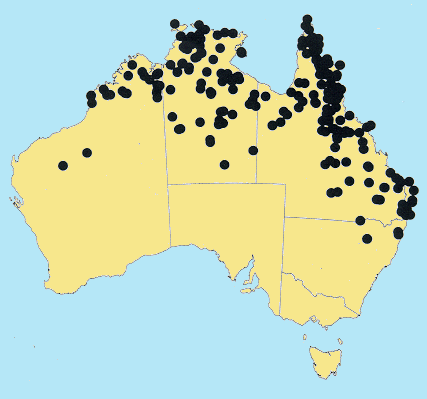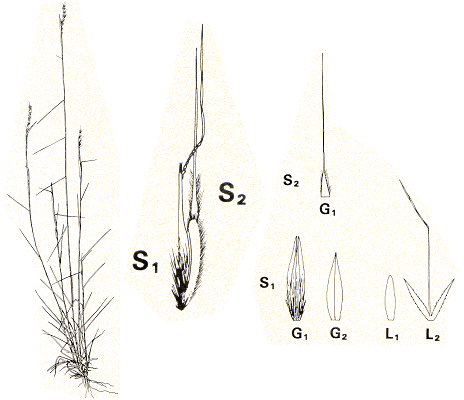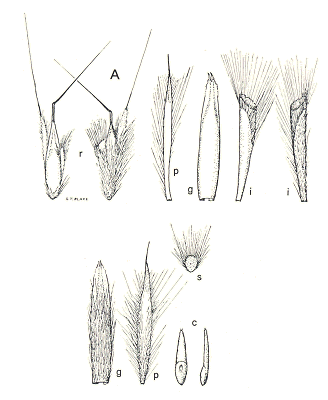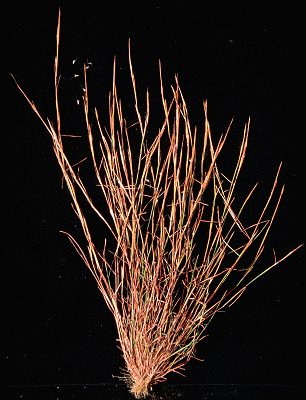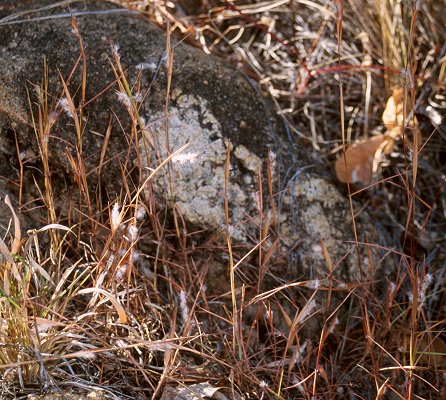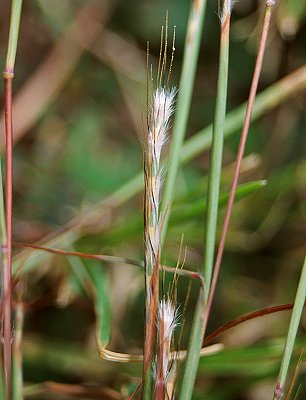Schizachyrium fragile (R.Br.) A.Camus. Ann.
Soc. Linn. Lyon 70: 87 (1924).
Classification. (GPWG 2001) : Subfamily
Panicoideae. Andropogoneae.
Basionym and/or
Replacement Name: Andropogon
fragilis R. Br., Prodr. 202 (1810).
Type of Basionym or
Protologue Information: Australia: Queensland: Endeavour River, Banks
& Solander s.n. (HT: BM (photo, BRI); IT: BRI (fragm.), NSW) "(T)
Littora Novae Hollandiae intra tropicum".
Recent synonyms:
S. obliqueberbe.
Key references
(books and floras): [1810]. R.Brown, Prodromus (202 as Andropogon
fragilis), [1878] G.Bentham, Flora Australiensis 7 (535 as Andropogon
fragilis), [1952] C.A.Gardner, Flora of Western Australia 1 Gramineae
(334 as S. brevifolium, 336 as S. obliqueberbe), [1981]
M.Lazarides in J.Jessop (ed)., Flora of Central Australia (490), [2002]
D.Sharp & B.K.Simon, AusGrass, Grasses of Australia, [2008]
S.W.L.Jacobs, R.D.B.Walley & D.J.B.Wheeler, Grasses of New South Wales
(365).
Illustrations:
[1952] C.A.Gardner, Flora of Western Australia 1 Gramineae (335,
Pl.98 as S. brevifolium), [1984] N.T.Burbidge. rev. S.W.L.Jacobs, Australian
Grasses (237), [2008] S.W.L.Jacobs,
R.D.B.Whalley & D.J.B.Wheeler, Grasses of New South Wales, 4th edn
(365).
Habit. Annual.
Culms erect, stature slender to delicate, 10–75 cm tall, 0.8–1.1 mm diam.
Lateral branches simple or sparsely branched. Leaves basal and cauline. Ligule
a fringed membrane, a ciliolate membrane, 0.3–0.6 mm long. Leaf-blades flat or
conduplicate, 2–10 cm long, 1–3 mm wide. Leaf-blade surface scaberulous.
Inflorescence.
Inflorescence solid or compound, a rame, a panicle of rames. Rhachis fragile at
the nodes.
Spikelets.
Spikelets sessile, 1 in the cluster. Companion spikelets pedicelled, 1 in the
cluster. Companion spikelets represented by single glumes, 1–3.5 mm long. Companion
spikelet glumes awned. Fertile spikelets 2-flowered, the lower floret barren
(rarely male), the upper fertile, comprising 1 basal sterile florets,
comprising 1 fertile floret(s), without rachilla extension, lanceolate or
oblong or ovate, dorsally compressed, 5–10 mm long.
Glumes.
Glumes dissimilar, firmer than fertile lemma. Lower glume lanceolate,
chartaceous, keeled, 2-keeled, winged on keel, winged broadly or moderately or
narrowly, 3–5 -nerved. Lower glume surface glabrous or indumented. Upper glume
lanceolate, chartaceous, keeled, 1-keeled, winged on keel, 1–3 -nerved. Florets.
Basal sterile florets 1, barren, without significant palea. Lemma of lower
sterile floret membranous, 0 -nerved.
Fertile lemma 3–4 mm
long, without keel. Lemma apex lobed, awned, 1 -awned. Median (principal) awn
from a sinus, 9–15 mm long overall, with a twisted column. Column 5 mm long.
Palea absent. Anthers 3. Grain 2.1–4 mm long.
Continental
Distribution: Temperate Asia, Tropical Asia, Australasia, and Pacific.
Australian
Distribution: Western Australia, Northern Territory, Queensland, New South
Wales.
Northern Territory:
Darwin & Gulf, Victoria River, Barkly Tableland, Central Australia North. Queensland:
Burke, Burnett, Cook, Darling Downs, Leichhardt, Maranoa, Mitchell, Moreton,
North Kennedy, Port Curtis, South Kennedy, Warrego, Wide Bay. New South
Wales: North Coast, North-Western Plains.
Notes. A fairly
common annual on sandy soils from the savanna regions of tropical Australia and
extending to sub-tropical Qld and N.S.W. where it is not so common. Occurs also
in S China, the Marianas, Caroline and Aru Is. and New Caledonia. Flowers
Jan.--Nov.
